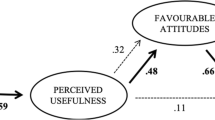Abstract
In this cross-sectional study, the principles of a technology acceptance model were used to identify variables related to the level of Internet usage by older adults. Community-dwelling older adults aged 60–88 years completed a postal questionnaire survey that elicited responses on the use of the Internet. Out of a sample of 592 older adults (236 males and 356 females), 50.7% used the Internet. A multiple linear regression analysis was carried out on the Internet users sample using the self-reported number of hours of Internet usage per week as the dependent variable. The results indicated that attitude toward using the Internet and good health status were statistically significant predictors of the level of Internet usage. A second multiple regression analysis using Internet activity as the dependent variable showed that attitude, usefulness, good health, and gender (males) were significant predictor variables.

Similar content being viewed by others
References
White, H., McConnell, E., Clipp, E., Bynum, L., Teague, C.: Surfing the net in later life: a review of the literature and pilot study of computer use and quality of life. J. Appl. Gerontol. 18(3), 358–378 (1999)
Karavidas, M., Lim, N.K., Katsika, S.L.: The effects of computers on older adults. Comput. Human Behav. 21, 697–711 (2005)
National Statistics Online, 2008, http://www.statistics.gov.uk, accessed 20th March 2009
Curran, K., Walters, N., Robinson, D.: Investigating the problems faced by older adults and people with disabilities in online environments. Behav. Inf. Technol. 26(6), 447–453 (2007)
Hart, T.A., Chaparro, B.S., Halcomb, C.G.: Evaluating websites for older adults: adherence to ‘senior-friendly’ guidelines and end-user performance. Behav. Inf. Technol 27(3), 191–199 (2008)
Freese, J., Rivas, S., Hargittai, E.: Cognitive ability and internet use among older adults. Poetics 34, 236–249 (2006)
Nayak, L., Priest, L., Stuart-Hamilton, I.: Website design attributes for retrieving health information by older adults: application of architectural criteria. Univ. Access. Inf. Soc. 5, 170–179 (2006)
Priest, L., Nayak, U.S.L., Stuart-Hamilton, I.: Website task performance by older adults. Behav. Inf. Technol. 26(3), 189–195 (2007)
Morris, A., Goodman, J., Brading, H.: Internet use and non-use: views of older adults. Univ. Access. Inf. Soc. 6(1), 43–57 (2007)
Fox, S. Older Americans and the internet. http://www.pewinternet.org/PPF/r/117/report_display.asp (2004). Accessed 17th March 2009
Huang, H.M., Liaw, S.S.: Exploring users’ attitudes and intentions toward the web as a survey tool. Comput. Hum. Behav. 21, 729–743 (2005)
McGuire, W.J.: Attitudes and attitude change. In: Lindsey, G., Aronson, E. (eds.) Handbook of social psychology, 3rd edn, pp. 233–246. Random House, NY (1985)
Zhang, Y.: Development and validation of an internet use attitude scale. Comput. Educ. 49, 243–253 (2007)
Davis, F.D.: Perceived usefulness, perceived ease of use, and user acceptance of information technology. MIS Q. 13(3), 319–340 (1989)
Bruner, G.C., Kumar, A.: Explaining consumer acceptance of handheld internet devices. J. Bus. Res. 58, 553–558 (2005)
Moon, J.W., Kim, Y.G.: Extending the TAM for a world-wide-web context. Inf. Manag. 38, 217–230 (2001)
Seyal, A.H., Pijpers, G.G.M.: Senior government executives’ use of the internet: a Bruneian scenario. Behav. Inf. Technol. 23(3), 197–210 (2004)
Shih, H.P.: Extended technology acceptance model of internet utilization behaviour. Inf. Manag. 41, 719–729 (2004)
Mahmood, M.A., Burn, J.M., Gemoets, L.A., Jacquez, C.: Variables affecting information technology end-user satisfaction: a meta-analysis of the empirical literature. Int. J. Hum. Comput. Stud. 52, 751–771 (2000)
DiMaggio, P., Hargittai, E., Celeste, C., Shafer, S.: Digital inequality: from unequal access to differentiated use. In: Neckerman, K. (ed.) Social inequality, pp. 355–400. Russell Sage Foundation, New York (2004)
Lenhart, A., Horrigan, J.: Re-visualizing the digital divide as a digital spectrum. IT Soc. 1, 23–39 (2003)
Nayak, U.S.L.: Elders-led design. Ergon. des. 1(1), 8–13 (1995)
Birmingham University Ethical Code of Practice. http://www.ppd.bham.ac.uk/policy/cop/code8.htm (2002)
Cronbach, L.J.: Coefficient alpha and the internal structure tests. Psychometrika 16, 297–334 (1951)
Nunnally, J.C., Berstein, I.H. Psychometric theory, 3rd edn. McGraw (1994)
Holt, D.T., Crocker, M.: Prior negative experiences: their impact on computer training outcomes. Comput. Educ. 35, 295–308 (2000)
Martínez-Torres, M.R., Toral Marín, S.L., Barrero García, F., Gallardo Vázquez, S., Arias Olivac, M., Torres, T.: A technological acceptance of e-learning tools used in practical and laboratory teaching, according to the European higher education area. Behav. Inf. Technol. 27(6), 495–505 (2008)
Durndell, A., Haag, Z.: Computer self efficacy, computer anxiety, attitudes towards the internet and reported experience with the Internet, by gender, in an East European sample. Comput. Hum. Behav. 18, 521–535 (2002)
Papastergiou, M., Solomonidou, C.: Gender issues in Internet access and favourite internet activities among Greek high school pupils inside and outside school. Comput. Educ. 44, 377–393 (2005)
Liaw, S.S.: An Internet survey for perceptions of computers and the World Wide Web: relationship, prediction, and difference. Comput. Hum. Behav. 18, 17–35 (2002)
Demiris, G., Rantz, M.J., Aud, M.A., Marek, K.D., Tyrer, H.W., Skubic, M., Husam, A.A.: Older adults’ attitudes towards and perceptions of ‘smart home’ technologies: a pilot study. Inform. Health. Soc. Care. 29(2), 87–94 (2004)
Hartwick, J., Barki, H.: Explaining the role of user participation in information systems use. Manage. Sci. 40(4), 440–465 (1994)
Acknowledgments
The authors wish to acknowledge the financial support given by the Health Foundation, London, United Kingdom, to carry out this research.
Author information
Authors and Affiliations
Corresponding author
Rights and permissions
About this article
Cite this article
Nayak, L.U.S., Priest, L. & White, A.P. An application of the technology acceptance model to the level of Internet usage by older adults. Univ Access Inf Soc 9, 367–374 (2010). https://doi.org/10.1007/s10209-009-0178-8
Published:
Issue Date:
DOI: https://doi.org/10.1007/s10209-009-0178-8




